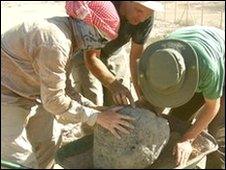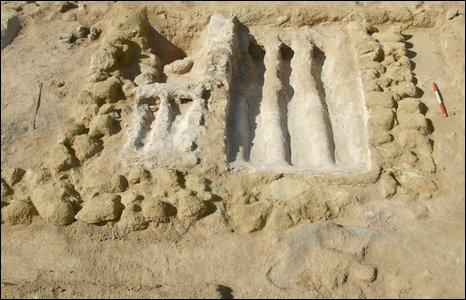Settlement found under Qatar sand by Lampeter academic
- Published

The archaeologists were not prepared for the scale of their find
A Welsh academic has revealed how he discovered a Middle East settlement buried under sand for about 125 years.
Dr Andrew Petersen first became aware of a possible settlement after finding masonry and pottery at Ras Al-Sharig in Qatar.
He thought something might be there after reading sources naming a town called Rubayqa.
"But we certainly weren't prepared for the scale of the find," said the expert from the University of Wales, Lampeter.
The haul includes the remains of a fort, a mosque, several industrial and domestic buildings, and 100 kilos of pottery and artefacts.

A hoard of 19th Century silver Indian Rupees hidden within a mosque wall
Among the more unusual discoveries were Indian rupee coins set into the walls of a building believed to have been a mosque, porcelain originating from as far afield as China and Burma, and several date presses, even though dates are impossible to grow in the area.
However, Dr Petersen, a specialist in Islamic archaeology, and the team from the Qatar Museums Authority are more puzzled at what they did not find.
"Aside from the mosque, there's very little evidence of cultural or domestic life. It appears that this was a very early example of an industrial settlement, with only very basic barrack-style accommodation.
"The principal industry seems to have been processing sugars and oil from dates, and given that they're not native to the region, they must have been brought in by sea, probably from the world's biggest oasis in Al-Hasa, Saudi Arabia, measuring over 100 miles end to end."
He said the whole site was "baffling".
"Despite being located on the coast, there's none of the artefacts you'd expect to find, connected with fishing or pearl diving.
"Also, given that it's on a natural deep water harbour, rare on the Qatari coast, it's strange that there's no evidence of even more extensive trade links with the outside world.
"The best theory we can come up with at the moment is that Rubayqa was used as some sort of processing and storage facility for nomadic tribes who'd stock up there before wandering the deserts of the Arabian hinterland."

Interior of prayer hall of mosque found at the site in Qatar
Almost as big a mystery surrounds who lived or worked there, and why they abandoned it.
Dr Petersen believes that documentary evidence in Turkey points towards an Ottoman Empire outpost in the area, from as early as the 15th Century.
It is thought that the Ottomans seized territory to use as a base from which to invade neighbouring Bahrain.
Qatari sources point to a major attack on Rubayqa during the 1760s by the Wahhabi tribe from what is now Saudi Arabia.
Burnt roofing timbers
The last human occupation of the site has been dated from remains as being around the 1890s, but why it was finally left to the sands is unclear.
"We suspect that there was another major assault on Rubayqa in the 1890s, possibly even larger than the attack during the 1760s," Dr Peterson added.
"We've found burnt roofing timbers on top of day-to-day objects, which would suggest that the fires occurred suddenly, and while the buildings were still occupied.
"This is probably why the inhabitants fled, but who attacked them, and why they never came back is a mystery which can only be revealed through further excavations over the next few years."